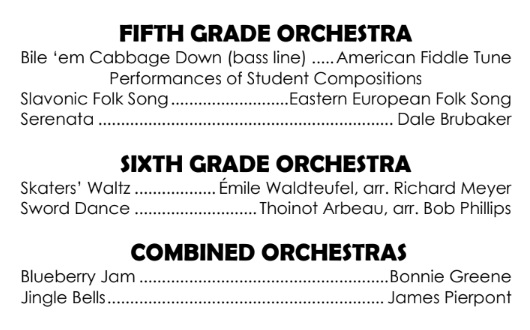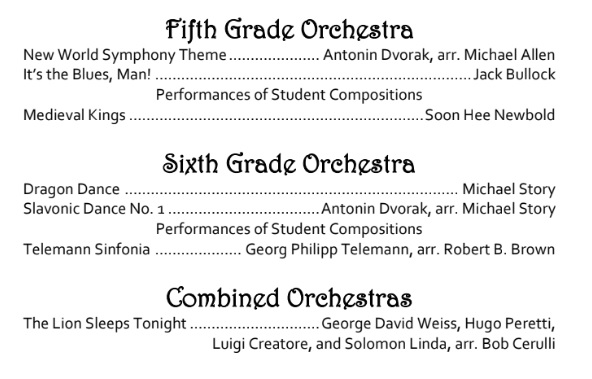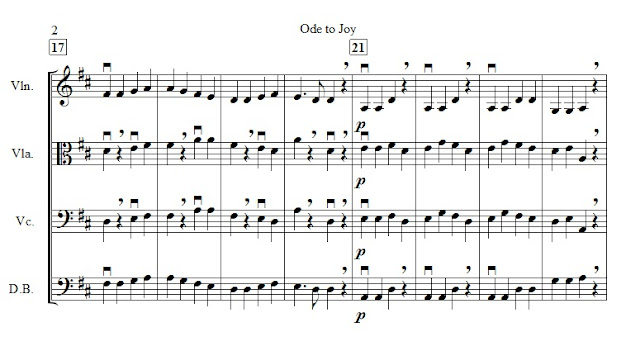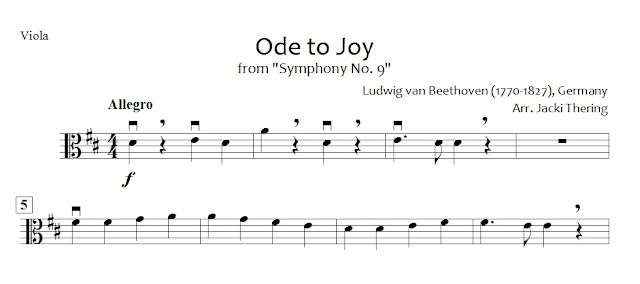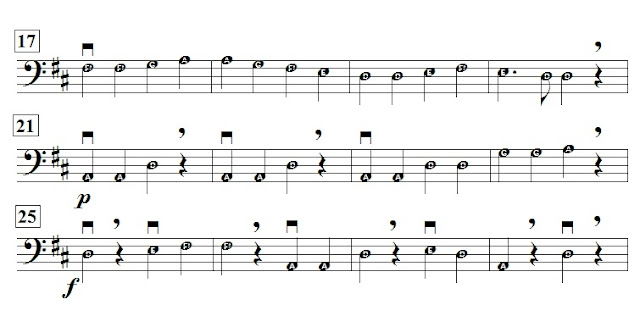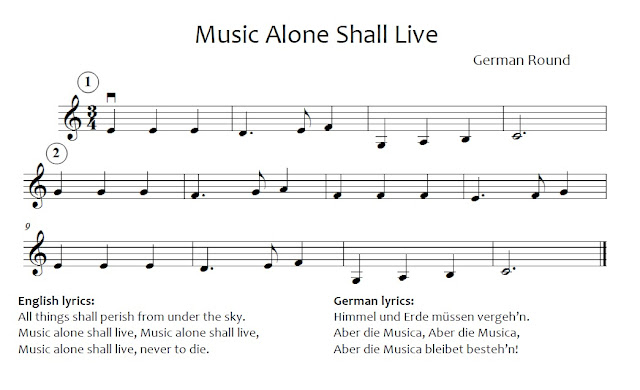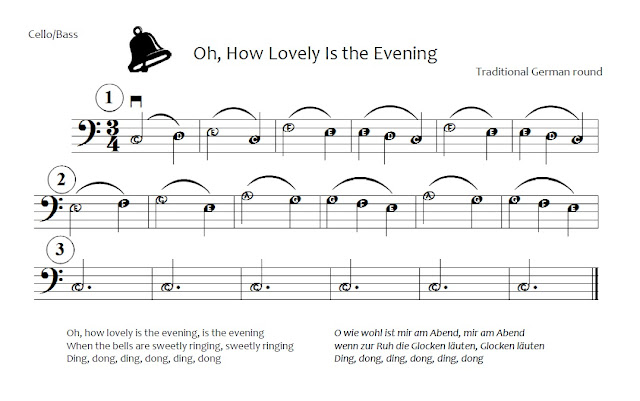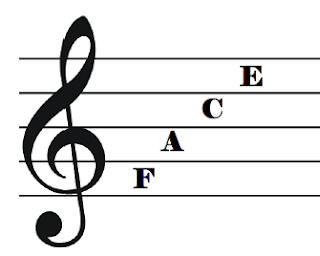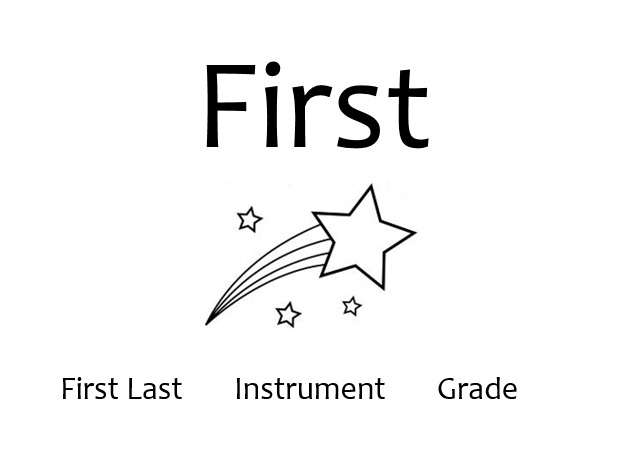Monday, December 9, 2019
Name That Tune--Concert Prep
For our last small group before a concert, we'll often play "Name that Tune." First we rosin bows as I walk through the call time and concert details with the students. Then, for "Name that Tune" I'll play a note or two or three of a part of one of their concert pieces. Once someone correctly identifies the piece, I have students pull out their music to find the measure number(s) of the excerpt, and then we play the whole piece together and touch up whatever needs touching up.
A variation on this game is to make it rhythm only, and I'll clap a distinctive rhythmic pattern from each of their pieces. Another variation (challenge) would be to include an excerpt or rhythm pattern that a different instrument plays--not a part that the specific kids in that small group play.
I'm often surprised by which students are quickly able to identify the concert piece--they're not always the strongest players--and the students like the game aspect of it (though we do not keep score in any way or recognize winners or anything). It's also more of a fun way to review the different concert pieces than just playing through everything once more before the concert.
When we play through concert pieces on this day, I like to play a different instrument's part along with the students (like I'll play cello with a violin group or violin with a bass group etc.). It helps to develop their chamber music skills and makes students more aware of what another instrument is doing while they're playing their part. And there are always students surprised that I know how to play a different instrument than they're used to seeing me play :) I also get students who look at the white board when they arrive and ask which song is "Name that Tune"...
At the end of this small group, we'll use a cloth to wipe the rosin dust off our strings and instruments so they're totally set to go for the concert, we'll get our music in concert order, and then I always ask which piece they're each most looking forward to performing at the concert.
What kind of lesson plans work well for you as you approach a concert?
Monday, October 7, 2019
Window Covering
At my schools, we need to have a window covering handy in case of a lockdown. I taped a few pieces of construction paper together, laminated them, added stickers, and then used Velcro to attach it to the door: voila! During the school year, I'll tape student compositions or pictures of students or music quotes so the door is more interesting to look at.
Monday, September 16, 2019
Hall Pass
I was cleaning out a cabinet the other day and came across these playing card hall passes I forgot I had made :) These must have been from my first year or two of teaching. Students come to full orchestra directly from lunch, so I would have made these for students to bring to lunch and show to the lunch supervisors as their hall pass to orchestra (and as a reminder for students not to head out for recess that day). The playing cards are published by Alfred and feature a composer and bio on one side. I added the hall pass info on the back side and laminated them. Students would pick one up the morning they drop off their instrument in the band/orchestra room, and then return their card upon arriving to full band/orchestra. Now I meet students in the cafeteria, so the cards are not really needed.
- Text for back of playing cards (Word document)
- Text for back of playing cards (PDF)
Since then, one of my schools has bought badge holders (something like this) to use for hall passes, so I color-printed this document double-sided (see below) and delivered a set to each classroom. Students grab one out of their class basket as they leave for their small group for the week as their hall pass to walk to band or orchestra.
Monday, August 19, 2019
Concert Repertoire for Beginning Orchestra
For winter and spring concerts at my schools, we have a combined orchestra, band, and choir concert that ideally lasts about an hour. The orchestra portion tends to run about 25 minutes total, so a few pieces performed by the first-year orchestra, a few pieces by the second-year orchestra, and then one or two combined pieces rounds out the orchestra portion. I meet with my students once a week for 30 minutes during recess for full orchestra and 30 minutes once a week during the school day for small group learning, so these pieces are representative of what students can comfortably have concert-ready.
Here is what my students performed last year at these concerts:
Winter Concert
Beginners:- Bile 'em Cabbage Down (students plucked an open string harmony part while I played the melody on the violin)
- Slavonic Folk Song (pizz. open string harmony, then pizz. melody, then arco melody/harmony together)
- Serenata by Dale Brubaker (all open strings, arco)
2nd Year Students:
- Skaters' Waltz by Émile Waldteufel, arr. Richard Meyer (in preparation for the next month's district-wide String Fest)
- Sword Dance by Thoinot Arbeau, arr. Bob Phillips
Combined Orchestras:
- Blueberry Jam by Bonnie Greene (in preparation for the next month's district-wide String Fest)
- Jingle Bells by James Pierpont (my arrangement)
Spring Concert
Beginners:- Ode to Joy (my arrangement)
- It's the Blues Man! (from their Orchestra Expressions book, complete with student soloists improvising the rhythms during their 4-measure solo)
- Student compositions (one four-measure composition per instrument)
- St. Lawrence Overture by Elliot Del Borgo (their first "real" full orchestra piece with independent parts)
2nd Year Students:
- Spring by Antonio Vivaldi, arr. Richard Meyer
- Student compositions (two eight-measure compositions--one for upper strings and one for lower strings)
- Fiddles on Fire by Mark Williams
Combined Orchestras:
- The Lion Sleeps Tonight (arr. Bob Cerulli)
This general format has been working well--in December, I like to start with something that's pizzicato open strings to show where the beginners started at the beginning of the year (and because students would be really comfortable performing that) and work up to something that's arco with D string notes. And the 2nd year students tend to play fewer pieces (about two big pieces alone) because theirs are longer in length. If we do only one combined piece at the end, 2nd year students may play three pieces alone; if we do two combined pieces, 2nd year students generally play two pieces alone.
Here are some of the pieces my students have performed for past winter and spring concerts listed in no particular order (student compositions are on every concert too):
Winter Concert
Beginners:
Pizzicato open strings (one piece)
- Les Toreadors (from Orchestra Expressions)
- Three Point Shot (from Orchestra Expressions)
- Bile 'em Cabbage Down (from Orchestra Expressions supplement)
Arco open strings (one piece)
- Serenata by Dale Brubaker (a winter concert tradition!)
Second Year Students:
A round or something pretty simple (one or two pieces--some years I don't do one of these on the concerts and choose two full orchestra pieces instead)
- Hallelujah by William Boyce (easy round in D Major)
- Brudenell Waltz by David R. Bellwood
- I Got Rhythm by George Gershwin and Ira Gershwin, arr. Michael Story
- Skaters' Waltz by Émile Waldteufel, arr. Richard Meyer
- Sword Dance by Thoinot Arbeau, arr. Bob Phillips
- Linus and Lucy by Vince Guaraldi (my arrangement that I got permission from the copyright holder to write--sorry, can't share)
- Appalachian Hymn by Soon Hee Newbold
- Hey Fiddle Fiddle! by Brian Balmages
- Les Toreadors by Georges Bizet (my arrangement)
- Blue Danube by Johann Strauss II (my arrangement)
- Ukrainian Bell Carol by Mykola Leontovich, arr. Sandra Dackow
Combined Pieces:
We always end with Jingle Bells! If we do a second combined piece on this concert, it would be a String Fest piece
- Star of the County Down (melody for 2nd year students; harmony for beginners)
- Variations on a Sea Shanty (my arrangement)
- Linus and Lucy by Vince Guaraldi (my arrangement that I got permission from the copyright holder to write--sorry, can't share)
- Jingle Bells (my arrangement)
Spring Concert
Beginners:Very simple full orchestra piece or a piece from the book
- New World Symphony Theme by Antonín Dvořák, arr. Michael Allen
- Ode to Joy by Ludwig van Beethoven (my arrangement)
- A Traveler's Song (from Orchestra Expressions--played Andante, then Allegro)
Piece from book with student soloists improvising their own rhythms (they play a 4-measure solo, deciding which quarter notes to change to pairs of eighth notes). We play a total of four times--first and last times with everyone playing the melody, the second and third times with soloists to include 6 soloists total.
- It's the Blues Man! (from Orchestra Expressions)
"Real" full orchestra piece
- Medieval Kings by Soon Hee Newbold
- St. Lawrence Overture by Elliot Del Borgo
- First Scale March by Mark Williams
- Royal Promenade by Don Brubaker
Second Year Orchestra:
Two or three full orchestra pieces, possibly one brought back from January's String Fest
- Dragon Dance by Michael Story
- Slavonic Dance No. 1 by Antonín Dvořák, arr. Michael Story
- Jupiter by Gustav Holst (my arrangement)
- Anasazi by John Edmondson
- Fiddles on Fire by Mark Williams
- Honor and Glory by Soon Hee Newbold
- Celtica by Brian Balmages (when I have an advanced violinist who can handle the solo part)
- Rite at Stonehenge by Elliot Del Borgo
Or something a little different
- The Blue Balloon from The Blue Book of Violin Tunes by Bonnie Greene (learned by ear)
Combined Orchestras:
- The Lion Sleeps Tonight by George David Weiss, Hugo Peretti, Luigi Creatore, and Solomon Linda, arr. Bob Cerulli
- Spring by Antonio Vivaldi, arr. Richard Meyer
- Sailors' Song by Mark Williams
- Slavonic Dance by Antonín Dvořák, arr. Richard Meyer
- William Tell Overture by Gioachino Rossini (my arrangement)
- We Will Rock You by Brian May, arr. Paul Lavender
For a more in-depth look at my winter concerts including logistics and sample speaking parts, please see this post :)
Which pieces do you like to program for a beginning orchestra concert? Which pieces should I consider for future concerts?
Tuesday, August 13, 2019
Beginning-of-the-Year Bulletin Boards
As I'm entering my ninth [edit: 11th] year of teaching elementary orchestra, I'm starting to get a collection of beginning-of-the-year bulletin board ideas, so here they are all in one place (with links to each post below the picture):
Labels:
beginning of the year,
bulletin board,
composers,
composition,
conducting,
diversity,
history,
instrument parts,
instruments,
metronome,
music history,
music literacy,
scale,
tempo
Monday, August 12, 2019
Metronome Beginning-of-the-Year Bulletin Board
Happy fall! For this beginning-of-the-year bulletin board, a huge shout-out goes to my mom for coming up with the rhyme and to my sister for drawing and painting the metronome! I always like including something educational on bulletin boards, so I posted definitions of the different tempo markings, a brief history of the metronome, and an explanation of metronome markings.
Here is a PDF and Word document of the text boxes and a a Google doc of the rhyme. Feel free to use!
Monday, July 8, 2019
Ode to Joy Arrangement
Here is a very simple arrangement of Beethoven's "Ode to Joy" that I used with my beginning orchestra last year. Each instrument has a turn playing melody and harmony. After the short introduction, violas and cellos begin on the melody together, while the violins and basses begin on the harmony together. The violas even get a solo measure in the introduction and ending! Every rest in this piece is a bow lift, so it's good practice for getting bows to match direction :)
The beginners were excited to have their first taste of playing a "real" full orchestra piece, where there are actual melody and harmony parts going on at the same time, and they enjoyed playing a piece that they recognized. I did play along on piano to provide some fuller harmonies but didn't write out a part for myself. Please let me know if you'd like me to write out a piano part for this! Update--see below for a notated piano part!
We watched parts of this Ode to Joy flash mob on Youtube too.
- Updated Ode to Joy with fewer bow lifts--parts/score/Alpha parts
- Score with piano part
- Piano part (would work with either version)
Enjoy!
Monday, June 24, 2019
Rounds by Ear
As we near the end of the school year, I like to teach a round by ear to the second-year students. Then in our final full orchestra rehearsals of the year, after the spring concert is over, we can play a two- or three-part round without the use of sheet music. The orchestra has been invited to play at the end-of-the-year assembly in recent years, and everyone lined up in the front of the gym and performed one of these rounds first in unison and then in parts. It was easy setup because I only needed chairs for the cellists--no stands required :)
Each of these are in the key of C Major, as that is the key we're focusing on during this time of the year, but the rounds could easily be transposed to the key of your choice. Students do get the sheet music eventually, but ideally they don't need it by then; it's just for reference. The sheet music documents include Alpha note versions at the end.
Music Alone Shall Live
Oh, How Lovely Is the Evening
Lachen
Enjoy!
Monday, May 13, 2019
End-of-Year Photo Gift
Throughout the school year, I take several pictures of students--during the first few weeks of school when the beginners are still plucking, once students have learned to hold their bow, concerts, Solo/Ensemble tours, etc. I like to display the pictures on the STAR Musician wall (see post here).
On the last day of orchestra, after students have tried out some pieces from their new summer packets, I give students a little photo memento. I order photos through Walgreens (waiting for a good deal to come up!), cut colorful paper in half, hand-write the following information on the back, and tape the photo to the front with double-sided scrap-booking tape.
Name, instrument
School name, grade
School year
Solo/Ensemble piece(s) and ensemble partner(s)
-My name
It's pretty simple, a little time consuming, but a nice memory for students of their year in orchestra.
Monday, April 8, 2019
Springtime Music Bulletin Board
A simple Google search for "spring music" brings up several titles, artists, and composers. I selected a few and added images of composers and scores (from imslp.org) along with some quick springtime clip art to create this springtime bulletin board.
Pieces/composers included (in no particular order):
- "Spring" from The Four Seasons by Antonio Vivaldi (1717)
- Appalachian Spring by Aaron Copland (1944)
- "Spring is Here" by Richard Rodgers and Lorenz Hart (1938), sung by Ella Fitzgerald
- Rite of Spring by Igor Stravinsky (1913)
- On Hearing the First Cuckoo in Spring by Frederick Delius (1912)
- "April Come She Will" by Simon & Garfunkel (1964)
Monday, March 11, 2019
Lines and Spaces for Each Clef
One of the strategies I use to teach the names of the notes on the staff is mnemonic devices (Good Burritos Don't Fall Apart: bass clef line notes, for example). This comes after students have learned the notes on the D, A, and G strings (just before the C/E string notes) and after students should be aware that the notes of the staff just follow the musical alphabet (ABCDEFGABCDEFG...). This is just another strategy to help remember the names of the line and space notes on the staff. Students are encouraged to create their own sentences and add them to the posters, which then get hung on the wall as reference.
TREBLE CLEF
Lines:
- Every Good Boy Deserves Fudge
- Every Good Boy Does Fine
- Empty Garbage Before Dad Flips
- FACE
ALTO CLEF
Lines:
- Find Alto Clef Extra Great
- Good Boys Deserve Fudge
- Good Boys Don't Fight
BASS CLEF
Lines:
- Good Burritos Don't Fall Apart
- Good Boys Do Fine Always
- All Cows Eat Grass
- All Cars Eat Gas
The handout is designed to be printed double-sided and then cut in half. Feel free to add your own mnemonic devices!
Monday, January 7, 2019
String Fest Seating Chart Template
Our annual district-wide String Fest is a big event for us to plan. One part of the planning process is figuring out where each of the 200+ elementary string players will sit in our giant combined orchestra. We want kids to share a stand with someone from their school but to sit near kids from other schools. We place second-year players in the front rows of the orchestra and first-year players in the back few rows. I'm not quite sure of the magic number of chairs/stands per row regarding space, so some rows end up being a little roomier than others--or we may rearrange a bit once we see everything set up in the field house--but at least we have a pretty close idea of where everyone will end up from the start.
This is pretty much my step-by-step process:
1. Determine number of students per instrument per grade level per school.
2. Draw orchestra seating chart, using dashes for stands (use pencil!).
3. Add dividing lines with colored pencil to show the different instrument sections and grade levels.
4. Number each stand from left to right for each row (violin side to cello side).
5. Write in school abbreviations for each stand, trying to be equal about school representation in the front row and outside stands (if there is an odd number of students at a school within a section, use a dash to pair up students from two different schools).
6. Include total number of chairs and stands per row at the bottom of the page.
7. Make a copy of the Google doc template, and then update the number of chairs per instrument/section/row in the copied document.
8. Change the font for the seat numbers (1A., 1B., etc.) to correspond with each of the schools.
9. Scan seating chart and share that and the Google doc with all orchestra teachers.
10. Now each teacher can add their students' names to the Google doc.
String Fest seating chart template
I do show students ahead of time where they'll sit and by whom, but then I also make name cards to tape on the music stands. I use the following Word document with Word's "mail merge" feature (Mailings/Start Mail Merge/Step-by-Step Mail Merge Wizard) to pull student names/instrument/grade level from an Excel sheet of my rosters. I'll also include an image of the school mascot to help students more quickly spot their own name card. And then, of course, I do color-code the cards by instrument. When printing, be sure to choose "2 pages per sheet." One of these years I will type up the row and seat number in the roster to include with the mail merge, but so far I've just been hand-writing the row and seat number on each card. I put the name cards in numerical order (by row, then seat number), and then it's quick work to set them on the proper stand and tape them up the day-of.
String Fest name card template (2 names per page to cut apart and tape on stand)
Subscribe to:
Posts (Atom)
